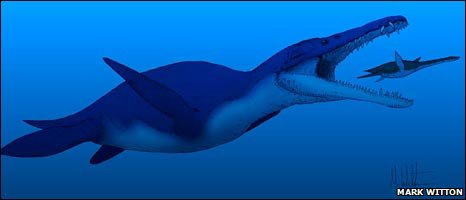Giant Sea Monster Discovered in the British Coast
Homepage > Dinosaur Discoveries - Giant Sea Monster
October 2009. The fossilized skull of a giant "sea monster"
was discovered in the British coast.
The ferocious predator, called pliosaur, terrorized other creatures of
the oceans about 150 million years ago.
The skull found is 8 feet (2.4 meters) long, and experts say it may belong to the largest pliosaur ever found, a marine reptile of up to 53 feet (16 meters).
The fossil was discovered by a local collector. It has been acquired by the municipality in the county of Dorset, who bought it with money from the Lottery Foundation.
The paleontologist Richard Forrest told the BBC: "I heard rumors that something big had appeared. But to see this in the flesh, so to speak, is simply overwhelming. It's simply gigantic.
 The
pliosaurs were a type of plesiosaur, a group of large aquatic reptiles
that ruled the seas around the same time that dinosaurs dominated the
earth.
The
pliosaurs were a type of plesiosaur, a group of large aquatic reptiles
that ruled the seas around the same time that dinosaurs dominated the
earth.
They had short necks and large heads similar to those of crocodiles, with powerful jaws and series of large, sharp teeth.
They had powerful muscles in the neck, and a powerful bite. Experts believe this could be the largest ever found pliosaur. The fossil includes the lower jaw and upper skull. Based on the size of the fossils found, one can infer that the animal was up to 53 feet (16 meters) from snout to tail and weighed between seven and twelve tons.
This means that this fossil can compete with the animals recently found in Svalbard (an archipelago in the Arctic Ocean), "The Monster" and "Predator X", measuring about 15 meters. It has nothing to envy from the "Monster of Aramberri, discovered in Mexico in 2002, which is believed to have similar dimensions. The specimen is still wrapped in rock formations, not prepared, but obviously that is in very good condition.
Richard Forrest, plesiosaur specialist, told the BBC that "the skulls of pliosaurs were very large, but generally not as robust, and usually are found ... totally squashed like a pancake."
"The most fascinating of the new skull is not only its sheer size, but is in three dimensions and without too many distortions," he said.
The fossil was found by a local collector in an area known as the Jurassic Coast, a stretch of 94 miles between Dorset and East Devon. The exact location of where the fossils were found has not been released because authorities want to avoid Dorset visits there. It is an area unstable and conducive to avalanches and landslides.
The geological department manager in Dorset, Richard Edmonds, said: "This part of the coast is eroding rapidly, which means that fossil that have been trapped and buried for centuries are often seen on the beach."
The collector was lucky to walk by the day that one of these fossils fell off the cliff. It was the clue he needed to keep looking around. He spent the next four years going every day and as a result discovered the amazing fossil.
Edmonds believes the rest of the monster could still buried in the cliff, but it could be decades before it becomes exposed.
Using Lottery funding, Dorset authorities acquired the jaw and skull of the pliosaur by about 20,000 pounds (U.S. $ 32,700).
According to scientists, will be a fantastic opportunity to extract valuable information about these giants of the seas and the world they inhabited.